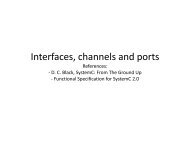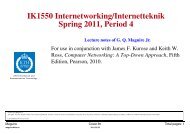An Overview of the PKCS Standards
An Overview of the PKCS Standards
An Overview of the PKCS Standards
You also want an ePaper? Increase the reach of your titles
YUMPU automatically turns print PDFs into web optimized ePapers that Google loves.
Page 18<br />
ERROR! STYLE NOT DEFINED.<br />
• maximum length <strong>of</strong> <strong>the</strong> name in terms <strong>of</strong> number <strong>of</strong> arcs (relative<br />
distinguished names) in <strong>the</strong> path<br />
• constraints on <strong>the</strong> relative distinguished names (specifically, <strong>the</strong> maximum<br />
number <strong>of</strong> "attribute-value assertions" in an arc, <strong>the</strong> allowed set <strong>of</strong><br />
attributes, and upper limits on <strong>the</strong> lengths <strong>of</strong> values)<br />
• conventions for names <strong>of</strong> particular types <strong>of</strong> object, e.g., organizations,<br />
residential persons, organizational persons, etc.<br />
• character-set concerns, such as which extensions to <strong>the</strong> T.61 character set<br />
are accepted, and when to choose, for example, T.61 as opposed to <strong>the</strong> 16-<br />
bit Universal Character Set<br />
RSA Laboratories intends to monitor conventions for naming and to report any progress<br />
in appendices to future releases <strong>of</strong> <strong>PKCS</strong>.<br />
6.2 Certification<br />
<strong>An</strong>o<strong>the</strong>r complicated issue is <strong>the</strong> meaning <strong>of</strong> certification: specifically, who is trusted to<br />
issue certificates, and to whom. Syntactically, any entity can sign a certificate as issuer<br />
with any entity as subject. Practically speaking, one would like to have some manner <strong>of</strong><br />
filtering out certificates whose issuer-to-subject relationship is questionable. For instance,<br />
one would probably question a certificate issued by one company to employees <strong>of</strong> ano<strong>the</strong>r<br />
company. One would also like to bound <strong>the</strong> length <strong>of</strong> certificate chains so that <strong>the</strong> chains<br />
can be found and represented easily. As with names, some work is underway to establish<br />
conventions for certification (see RFC 1422).<br />
Open issues here include:<br />
• what level <strong>of</strong> trust in <strong>the</strong> subject's identity is implied by a certificate<br />
• <strong>the</strong> correspondence between <strong>the</strong> directory tree and issuer-to-subject<br />
relationships<br />
• which entities can act as top-level certification authorities, having <strong>the</strong>ir<br />
public keys widely known<br />
• <strong>the</strong> maximum length <strong>of</strong> a certificate chain<br />
Some <strong>of</strong> <strong>the</strong> certification issues can be resolved with <strong>PKCS</strong> #6 extended certificates. For<br />
instance, one could define an extended-certificate attribute that indicates <strong>the</strong> authority <strong>of</strong> a<br />
certificate's subject to issue o<strong>the</strong>r certificates. <strong>An</strong>o<strong>the</strong>r attribute could indicate to what<br />
extent <strong>the</strong> subject can delegate authority. Such techniques are employed in <strong>the</strong> Electronic<br />
Document Authorization architecture [Fis90], but would require fur<strong>the</strong>r study before<br />
being included in <strong>PKCS</strong>.

















